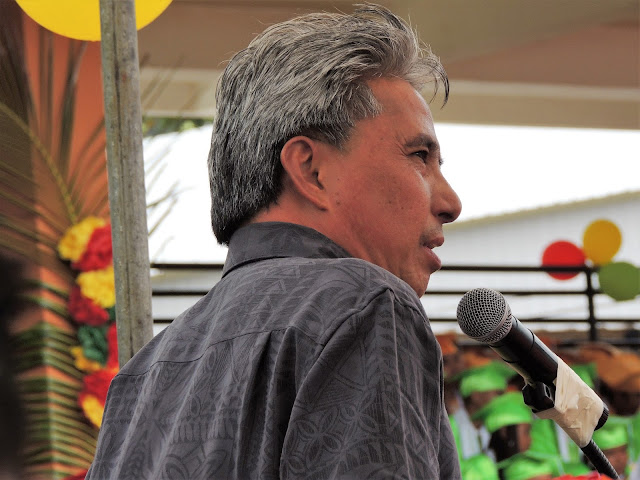Pohnpeian
Olympian In my trips to the track to run a few laps I’ve
gotten to know two coaches who are often there with young runners. Since the Micronesian track meet I wrote
about several weeks ago, these athletes have continued to train for an upcoming
Oceania Athletic Association track meet.
This larger association controls a much wider area of the Pacific, including
Australia, New Zealand and a lot of island groups around the FSM. Even more impressive, a couple of the young
people have earned bids to compete in the Olympics in Rio de Janeiro this
summer. Anyway, one of the coaches
introduced himself as Elias Rodriguez, the Pohnpeian marathoner who ran for the
FSM at the Sydney Olympics in 2000. As
noted in one of the reports of this race, “Rodriguez
finished last in the marathon but was cheered on by tens of thousands of
spectators and watched by millions of television viewers as he entered the
Olympic stadium for a final lap immediately prior to the closing ceremony which
was delayed to allow his finish.” When I
talked to him he described how cold and windy it was that day in Sydney. Having lived in this heat and humidity, I can
believe how difficult it must have been for him to run in the cold.
Indigenous Crafts One of the Peace Corps Response volunteers who is leaving the Island later this week took me to a small out-of-the-way Kolonia neighborhood which is inhabited by a group of people who are from one of the outer islands. They have chosen to live together, and a number of them continue to carry on native crafts. They are primarily known for intricate weaving of grass or reed and shells or for wood carving. We visited a couple of houses, the front rooms of which were stores displaying these items. Of more interest to me was an outdoor wood shop in which a half-dozen men were using a variety of handmade tools and files to carve objects out of various hardwoods. They were skilled craftsmen of the folk art variety. Most of their work was decorative, although one gentleman was making a fish trap. I asked another man if their designs and images were traditional. He indicated that they carved what they knew, but allowed that the designs were mainly influenced by the interests and desires of the few tourists who wandered through here—a pretty pure example of supply and demand. At some point, if Pohnpei becomes more of a tourist destination than it is now, I can envision these craftsmen moving “downtown.” Hasn’t happened yet. Anyway, before I leave there will be a wood carving or two in my suitcase.
Indigenous Crafts One of the Peace Corps Response volunteers who is leaving the Island later this week took me to a small out-of-the-way Kolonia neighborhood which is inhabited by a group of people who are from one of the outer islands. They have chosen to live together, and a number of them continue to carry on native crafts. They are primarily known for intricate weaving of grass or reed and shells or for wood carving. We visited a couple of houses, the front rooms of which were stores displaying these items. Of more interest to me was an outdoor wood shop in which a half-dozen men were using a variety of handmade tools and files to carve objects out of various hardwoods. They were skilled craftsmen of the folk art variety. Most of their work was decorative, although one gentleman was making a fish trap. I asked another man if their designs and images were traditional. He indicated that they carved what they knew, but allowed that the designs were mainly influenced by the interests and desires of the few tourists who wandered through here—a pretty pure example of supply and demand. At some point, if Pohnpei becomes more of a tourist destination than it is now, I can envision these craftsmen moving “downtown.” Hasn’t happened yet. Anyway, before I leave there will be a wood carving or two in my suitcase.
 |
| This will become a fish trap. |
Peace Corps Pre-Service Training A new group of 13 Peace Corps two-year recruits have arrived. They will live with families and teach school on islands throughout FSM. They are in their fourth week of a 12-week training regimen before their placement begins. They are living with families in Medolenihmw and attending classes daily in an old Catholic School. During this period they are receiving crash courses in culture, language, and teaching. The latter is where I come in. I am one of several Peace Corps Response Volunteers who have assisted in the education training segments. Yesterday, I taught a lesson on “assessment” and teamed up with a Peace Corps volunteer who is in her second year to present a lesson on building professional relationships with host country teachers. For the next several weeks I will also be observing their teaching in a model school that has been established to both provide summer school to students and teaching experience to these new teachers with little or no experience. As I watch and listen to them, there is a piece of me that is pretty envious. They are about to embark on two years living in remote areas with host families—an experience far more intense than what I am experiencing here in Kolonia. If only I were a half-century or so younger!
 |
| The new recruits. Above is my co-presenter, a PC volunteer in her second year in the Mortlock Islands. |
Hair I don't pretend to know fashion, but I have to believe a new hair style is sweeping the island. Young fashionistas are dyeing just the hair on the top of their heads bright colors. Red seems to be the most popular, followed by a sort of coppery orange--which I assume is as close to blond as these very dark-haired folks can get.
























































